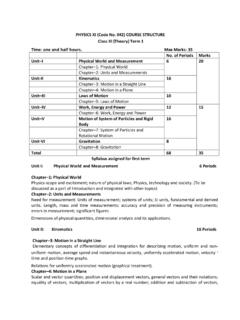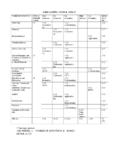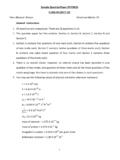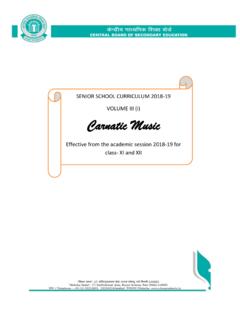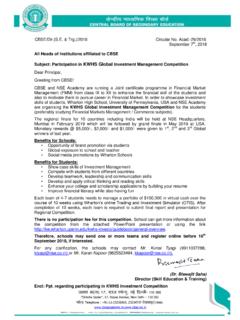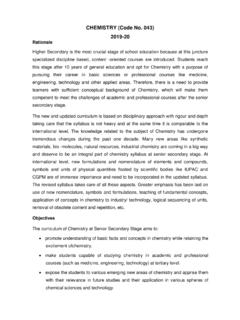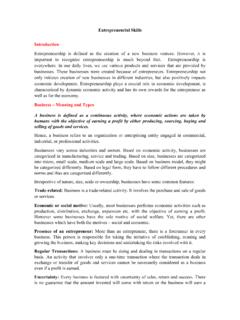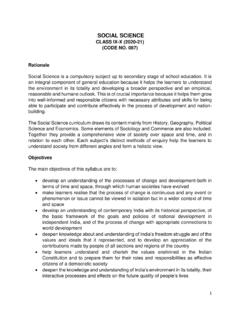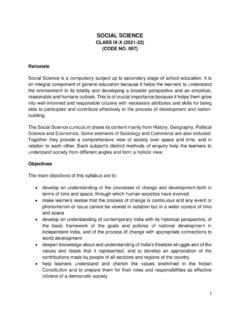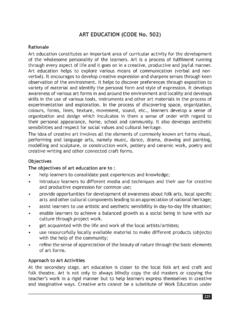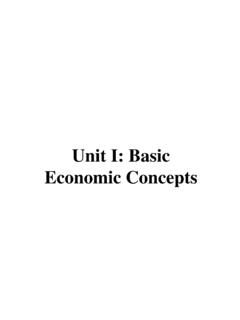Transcription of ECONOMICS (Code No. 030) (2020-21)
1 1 ECONOMICS (Code No. 030) (2020-21) Rationale ECONOMICS is one of the social sciences, which has great influence on every human being. As economic life and the economy go through changes, the need to ground education in children s own experience becomes essential. While doing so, it is imperative to provide them opportunities to acquire analytical skills to observe and understand the economic realities. At senior secondary stage, the learners are in a position to understand abstract ideas, exercise the power of thinking and to develop their own perception. It is at this stage, the learners are exposed to the rigour of the discipline of ECONOMICS in a systematic way. The ECONOMICS courses are introduced in such a way that in the initial stage, the learners are introduced to the economic realities that the nation is facing today along with some basic statistical tools to understand these broader economic realities.
2 In the later stage, the learners are introduced to ECONOMICS as a theory of abstraction. The ECONOMICS courses also contain many projects and activities. These will provide opportunities for the learners to explore various economic issues both from their day-to-day life and also from issues, which are broader and invisible in nature. The academic skills that they learn in these courses would help to develop the projects and activities. The syllabus is also expected to provide opportunities to use information and communication technologies to facilitate their learning process. Objectives: Understanding of some basic economic concepts and development of economic reasoning which the learners can apply in their day-to-day life as citizens, workers and consumers.
3 Realisation of learners role in nation building and sensitivity to the economic issues that the nation is facing today. Equipment with basic tools of ECONOMICS and statistics to analyse economic issues. This is pertinent for even those who may not pursue this course beyond senior secondary stage. Development of understanding that there can be more than one view on any economic issue and necessary skills to argue logically with reasoning. 2 ECONOMICS (030) CLASS XI (2020-21) Theory: 80 Marks 3 Hours Project.
4 20 Marks Units Marks Periods Part A Statistics for ECONOMICS Introduction 13 07 Collection, Organisation and Presentation of Data 27 Statistical Tools and Interpretation 27 41 40 75 Part B Introductory Microeconomics Introduction 4 4 Consumer's Equilibrium and Demand 13 32 Producer Behaviour and Supply 13 26 Forms of Market and Price Determination under perfect competition with simple applications 10 13 40 75 Part C Project Work 20 15 Part A.
5 Statistics for ECONOMICS In this course, the learners are expected to acquire skills in collection, organisation and presentation of quantitative and qualitative information pertaining to various simple economic aspects systematically. It also intends to provide some basic statistical tools to analyse, and interpret any economic information and draw appropriate inferences. In this process, the learners are also expected to understand the behaviour of various economic data. unit 1: Introduction 07 Periods What is ECONOMICS ? Meaning, scope, functions and importance of statistics in ECONOMICS unit 2: Collection, Organisation and Presentation of data 27 Periods Collection of data - sources of data - primary and secondary; how basic data is collected with concepts of Sampling; methods of collecting data; some important sources of secondary data: Census of India and National Sample Survey Organisation.
6 Organisation of Data: Meaning and types of variables; Frequency Distribution. 3 Presentation of Data: Tabular Presentation and Diagrammatic Presentation of Data: (i) Geometric forms (bar diagrams and pie diagrams), (ii) Frequency diagrams (histogram, polygon and Ogive) and (iii) Arithmetic line graphs (time series graph). unit 3: Statistical Tools and Interpretation 41 Periods For all the numerical problems and solutions, the appropriate economic interpretation may be attempted. This means, the students need to solve the problems and provide interpretation for the results derived. Measures of Central Tendency- Arithmatic mean, median and mode Measures of Dispersion - absolute dispersion standard deviation); relative dispersion co-efficient of variation) Correlation meaning and properties, scatter diagram; Measures of correlation - Karl Pearson's method (two variables ungrouped data) Introduction to Index Numbers - meaning, types - wholesale price index, consumer price index, uses of index numbers; Inflation and index numbers.
7 Part B: Introductory Microeconomics unit 4: Introduction 4 Periods Meaning of microeconomics and macroeconomics ; positive and normative ECONOMICS What is an economy? Central problems of an economy: what, how and for whom to produce; opportunity cost. unit 5: Consumer's Equilibrium and Demand 32 Periods Consumer's equilibrium - meaning of utility, marginal utility, law of diminishing marginal utility, conditions of consumer's equilibrium using marginal utility analysis. Indifference curve analysis of consumer's equilibrium-the consumer's budget (budget set and budget line), preferences of the consumer (indifference curve, indifference map) and conditions of consumer's equilibrium.
8 4 Demand, market demand, determinants of demand, demand schedule, demand curve and its slope, movement along and shifts in the demand curve; price elasticity of demand - factors affecting price elasticity of demand; measurement of price elasticity of demand percentage-change method. unit 6: Producer Behaviour and Supply 26 Periods Meaning of Production Function Short-Run and Long-Run Total Product, Average Product and Marginal Product. Returns to a Factor Cost: Short run costs - total cost, total fixed cost, total variable cost; Average cost; Average fixed cost, average variable cost and marginal cost-meaning and their relationships. Revenue - total, average and marginal revenue - meaning and their relationship.
9 Supply, market supply, determinants of supply, supply schedule, supply curve and its slope, movements along and shifts in supply curve, price elasticity of supply; measurement of price elasticity of supply - percentage-change method. unit 7: Forms of Market and Price Determination under Perfect Competition with simple applications. 13 Periods Perfect competition - Features; Determination of market equilibrium and effects of shifts in demand and supply. Simple Applications of Demand and Supply: Price ceiling, price floor. Part C: Project in ECONOMICS 20 Periods Guidelines as given in class XII curriculum 5 Suggested Question Paper Design ECONOMICS (Code No.)
10 030) Class XI (2020-21) March 2021 Examination Marks: 80 Duration: 3 hrs. SN Typology of Questions Marks Percentage 1 Remembering and Understanding: Exhibit memory of previously learned material by recalling facts, terms, basic concepts, and answers. Demonstrate understanding of facts and ideas by organizing, comparing, translating, interpreting, giving descriptions, and stating main ideas 44 55% 2 Applying: Solve problems to new situations by applying acquired knowledge, facts, techniques and rules in a different way.
